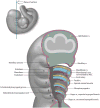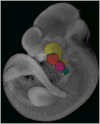Development and evolution of the pharyngeal apparatus
- PMID: 25176500
- PMCID: PMC4199908
- DOI: 10.1002/wdev.147
Development and evolution of the pharyngeal apparatus
Abstract
The oral or pharyngeal apparatus facilitates the dual functions of respiration and feeding. It develops during embryogenesis from transient structures called pharyngeal arches (PAs), which comprise a reiterated series of outgrowths on the lateral side of the head. The PAs and their segmental arrangement are highly conserved throughout evolution from invertebrate chordates such as amphioxus, through to vertebrate agnathans including avians, squamates, and mammals. The structural organization of the PAs is also highly conserved and involves contributions from each of the three primary endoderm, mesoderm, and ectoderm germ layers. The endoderm is particularly important for PA formation and segmentation and also plays a critical role in tissue-specific differentiation. The ectoderm gives rise to neural crest cells (NCC) which provide an additional layer of complexity to PA development and differentiation in vertebrates compared to invertebrate chordates that do not possess NCC. Collectively, the PAs give rise to much of the neurovasculature and musculoskeletal systems in the head and neck. The complexity of development renders the pharyngeal apparatus prone to perturbation and subsequently the pathogenesis of birth defects. Hence it is important to understand the signals and mechanisms that govern the development and evolution of the pharyngeal complex.
© 2014 Wiley Periodicals, Inc.
Figures






References
-
- Jones NC, Trainor PA. The therapeutic potential of stem cells in the treatment of craniofacial abnormalities. Expert Opin Biol Ther. 2004;4:645–657. - PubMed
-
- Scambler PJ. The 22q11 deletion syndromes. Hum Mol Genet. 2000;9:2421–2426. - PubMed
-
- Walker MB, Trainor PA. Craniofacial malformations: intrinsic vs extrinsic neural crest cell defects in Treacher Collins and 22q11 deletion syndromes. Clin Genet. 2006;69:471–479. - PubMed
-
- Sperber GH. Craniofacial development. 2001
-
- Le Douarin NMK. The Neural Crest. 1999
Publication types
MeSH terms
Grants and funding
LinkOut - more resources
Full Text Sources
Other Literature Sources

